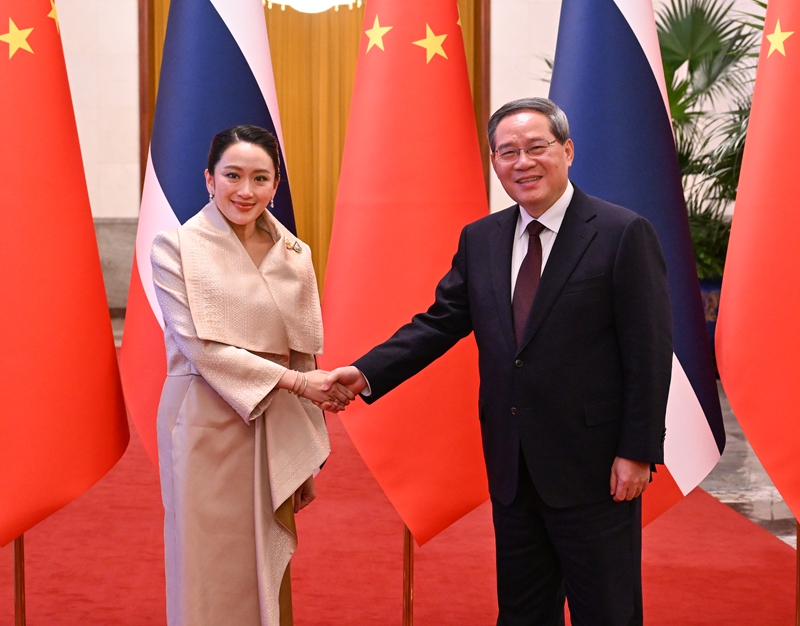Bank Of China: Using Financial Innovation As A Pen To Draw A New Picture Of RMB Internationalization
Bank Of China: Using Financial Innovation As A Pen To Draw A New Picture Of RMB Internationalization
The internationalization of the RMB is the core issue of China's high-level opening up of the financial industry and an important support for building a new dual circulation development pattern. As the most globalized Chinese bank, Bank of China has relied on its century of cross-border financial experience and a service network covering 64 overseas countries and regions with a century of cross-border financial experience and a service network covering 64 overseas countries and regions
The internationalization of the RMB is the core issue of China's high-level opening up of the financial industry and an important support for building a new dual circulation development pattern. As the Chinese bank with the highest globalization, Bank of China continues to play the role of the "main force" of RMB internationalization with its century of cross-border financial experience and a service network covering 64 overseas countries and regions.
From building a global clearing network to innovating diversified cross-border usage scenarios, to linking global partners to build an ecosystem, Bank of China has promoted the continuous deepening of its functions in trade settlement, investment and financing, reserve currencies and other fields with its actual performance and effectiveness, injecting strong financial momentum into the steady and prudent promotion of the internationalization of the RMB.
Build a solid foundation for clearing network
The internationalization of the RMB is inseparable from an efficient, safe and convenient cross-border clearing system. Bank of China has been deeply engaged in the construction of clearing network for more than 20 years. From the world's first RMB clearing bank in 2003, to the establishment of a comprehensive infrastructure matrix, it has continuously consolidated the "main artery" of cross-border circulation of RMB.
Bank of China actively expands the basis of the use of RMB around the world and has become an important builder of the global RMB clearing network. Up to now, Bank of China has served as RMB clearing banks in 16 countries and regions, covering key regions such as Asia, Europe, Africa, and the Americas, and qualifying for all three clearing banks in the African region.
In June this year, the Bank of China Mauritius RMB Clearing Bank opened, further extending the RMB service radius in Africa and enhancing the level of regional financial connectivity. In Southeast Asia, Bank of China has served as the RMB business clearing bank of Malaysia, the Philippines and Cambodia. In 2025, Vientiane Branch was also appointed as the Lao Digital RMB Clearing Bank, laying the foundation for the cross-border use of digital RMB in the region.
In 2024, Bank of China's cross-border RMB clearing business exceeded 1300 trillion yuan, an increase of 40.05% year-on-year, continuing to maintain its global leadership.
This achievement is inseparable from the in-depth participation of the Bank of China in the construction of the RMB Cross-border Payment System (CIPS). Currently, a total of 45 institutions have joined CIPS as direct participants and have represented indirect participation of more than 700 banking financial institutions around the world. 36 overseas institutions have achieved the launch of CIPS standard transceivers, becoming the main force in promoting the global circulation of RMB funds. At present, the number of direct participating banks, inter-participation banks and network coverage of Bank of China are in the market leading position.
The perfect clearing network not only improves the efficiency of cross-border use of RMB, but also provides more convenient local currency settlement services for Chinese and foreign companies. Taking the China-Laos Railway Project as an example, Bank of China has provided a total of more than 20 billion yuan in settlement and liquidation funds to project-related customers, and issued more than 150 guarantee letters, with an amount of more than 5.5 billion yuan.
The innovative application of digital RMB has further expanded the boundaries of the clearing network.
As the first financial institution to participate in the research and development of digital RMB, Bank of China not only achieved extensive pilot projects in retail and public scenarios in China, but also made many breakthroughs in the cross-border field: deeply participating in the multilateral central bank digital currency bridge () project, helping the UAE central bank complete the first "Digital Dirham" cross-border payment transaction; implementing digital RMB clearing services in Laos to provide technical support for cross-border settlement of digital RMB in Southeast Asia; participating in the development of digital Macau dollar system in Macau, and promoting the interconnection of digital currencies in the Guangdong-Hong Kong-Macao Greater Bay Area.
Empower cross-border usage scenarios
The clearing network is the foundation, and scenario application is the key to the real "live" of the RMB.
Bank of China has innovated financial products and service solutions around core scenarios such as trade settlement, investment and financing, and commodities, promoted the RMB from "acceptable" to "happy use", and continued to expand the real demand and use ecosystem of RMB.
In the field of trade settlement, Bank of China focuses on countries jointly built by the "Belt and Road" and member states of the Regional Comprehensive Economic Partnership Agreement (RCEP) to promote the normal use of the RMB in cross-border trade.
The Sihanoukville Port Special Economic Zone of Cambodia (Xigang Special Economic Zone) is a model of pragmatic cooperation between China and Cambodia. Now 175 companies have settled in. The Phnom Penh Branch of Bank of China actively promotes mobile banking and QR code payment among merchants in the Xigang Special Administrative Region, promoting the cross-border RMB settlement volume of enterprises in the region to exceed 1.2 billion yuan, and the number of RMB accounts and deposit balances doubled.
In Guangxi, the Guangxi Branch of Bank of China has linked to ZTO Payment to launch the "BOC Cross-border E-Commerce Connect·Three-Party Connect" system, which has implemented the first cross-border e-commerce inter-commerce collection business in Guangxi. In the future, it has successively completed the first digital RMB payment in the country in the border trade scenario, the first multilateral central bank digital currency bridge in the region and other digital currency innovation businesses.
Innovation in the investment and financing field further strengthens the financial attributes of the RMB. In August this year, Bank of China achieved a major breakthrough in the Australian market: it took multiple roles such as joint lead underwriting bookkeeping banks to form an international syndicated loan of RMB 14.2 billion for the world's leading iron ore producers. This is the first RMB syndicated loan from an Australian company and the largest overseas RMB syndicated loan from a non-Chinese-funded enterprise to date.
The development of the panda bond market has become an important tool for deepening the RMB investment and financing functions.
Bank of China has maintained the top ranking of panda bond underwriting shares in the interbank market for eleven consecutive years, assisting more than 70 overseas issuers in issuing nearly 300 panda bonds, raising more than 570 billion yuan in financing, and as the lead underwriter, it has implemented several "first orders" projects: in 2023, assisting Egypt in issuing the first African sustainable development panda bond, and in 2025, it helps the African Export-Import Bank to issue the first African multilateral development institution panda bond, and in July of the same year, it assisted Morgan Stanley Group in issuing the first US-funded issuer panda bond, attracting diversified investors around the world to subscribe.
RMB deduction and settlement in the commodity field is an important breakthrough for the internationalization of the RMB. Relying on its service experience in the fields of energy and minerals, Bank of China promotes RMB settlement of bulk trade such as iron ore, pulp, palm oil, etc. In Malaysia, we will promote the pilot program of RMB settlement for palm oil trade; in the Democratic Republic of the Congo, we will customize the closed loop of RMB procurement and sales for enterprises, achieving RMB sales transactions of RMB denominated copper products worth RMB 30 million.
Linking global ecological partners
The internationalization of the RMB is a systematic project that requires diversified coordination of policies, markets and institutions. Bank of China fully plays the role of a "bridge and link", links overseas central banks, financial institutions, enterprises and international organizations, etc., and builds an open, shared and secure RMB ecosystem.
Data shows that as of the end of 2024, Bank of China's overseas institutions covered 64 countries and regions, including 45 countries jointly built by the "Belt and Road"; in 2024, Bank of China handled cross-border RMB settlements of 43.06 trillion yuan and cross-border RMB clearing volume of 1314 trillion yuan, ranking first in the world.
Cooperation with global regulators is an important path for Bank of China to consolidate the foundation for the use of the RMB. In June 2025, Bank of China and CIPS signed a memorandum of cooperation to in-depth cooperation in areas such as participant network expansion and cross-border RMB investment and financing settlement; Thailand's subsidiary signed a CIPS standard transceiver cooperation agreement with Thailand Huishang Bank to achieve the first implementation of the device in Southeast Asia.
Bank of China has released the "Bank Internationalization White Paper" for 12 consecutive years, providing authoritative trend guidance for the market; held a RMB Internationalization Forum in Hong Kong in 2025, bringing together more than 300 representatives to participate; and held RMB Internationalization Market Promotion Events in more than a dozen countries and regions including Indonesia and the UAE. These activities not only strengthen market consensus, but also effectively enhance the international acceptance and recognition of the RMB.
Bank of China can become the main force in the internationalization of the RMB not only because of the construction of financial infrastructure and the expansion of RMB use scenarios, but also because of its long-term accumulation of ability to deepen international finance and local currency internationalization. Bank of China actively integrates into the national strategic layout, allowing the internationalization of the RMB to resonate with regional development.
In the Guangdong-Hong Kong-Macao Greater Bay Area, Bank of China launched the "Cross-Border Payment Connect" business, with a business volume of more than 10,000 on the first day. Hong Kong residents can complete cross-border remittances through mainland mobile banking without having to fill in their account information; the previous "Account Opening Easy" product in the Greater Bay Area has witnessed the opening of mainland accounts for more than 300,000 Hong Kong residents. At the Hainan Free Trade Port, Bank of China assisted the Ministry of Finance in issuing offshore RMB treasury bonds of 6 billion yuan, setting a new high in the issuance of single bonds in the Macau market, with a peak subscription scale of RMB 36.52 billion, and a subscription multiple of approximately 6.1 times.
From clearing nodes to scene integration, from regional pilots to global ecology, Bank of China is using financial power to draw a vivid picture of the internationalization of the RMB.





